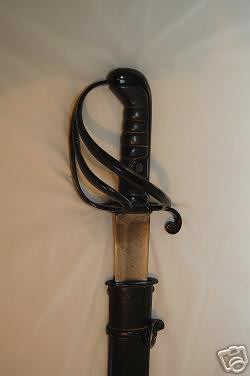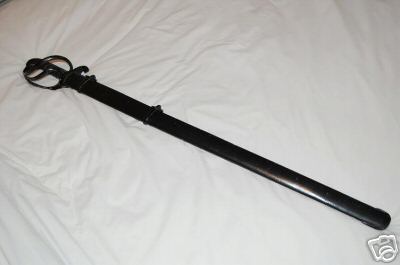Posts: 515
Thu 27 Mar, 2008 11:07 am
British Sword: Make year and service branch?
Posts: 1,377
Thu 27 Mar, 2008 11:13 am
:D
Morgan,
What is the blade length? The blade appears to be undecorated, is that correct? Can you make out the manufacturer's name on the spine on the blade? If it is British, it would be an 1821 pattern of some sort, probably either Light Cavalry or Royal Artillery Officer's sword. This hilt style was copied by other nations, one of which was in a fairly recent SFI thread and it was attributed to Portugal.
Jonathan
Posts: 515
Thu 27 Mar, 2008 11:20 am
I have asked about blade length and am waiting for a reply. The makers name does indeed look like craven. I'll let you know the length as soon as I hear. It is interesting looking though, isnt it? Here is what the owner has to say:
The blade is stamped to Thomas Craven of Birmingham on the back edge. Craven was known to be working from 1818-1820. The blade itself is in good clean condition and has been given a spear point. These blades would originally been manufactured with a hatchet point but since Waterloo were ground to a spear point as they were reckoned to be more effective. As you can see from the pictures, the blade is very slightly rounded to the tip.
The hilt is the regulation three bar 1822 pattern with wooden grip and has no covering to it. I assume that this has been attached to the blade at a later stage as I can find no records of these swords being manufactured anywhere. The only contemporary answer I can give to this is that it may have been put together by an Officer to keep up with regulation pattern but the other alternative is that it is a much later “cut and shut” made by a collector. This could explain the crudeness of the pin that has been used to attach the tang to the hilt through the ears of the backpiece.
The scabbard is again a 1796 Heavy Cavalry Trooper’s scabbard and is great condition apart from a small dent to one side. It still has both hanging rings intact.
Both the hilt and the scabbard are painted black and again the only contemporary answers are that it had some kind of naval use or that it was painted for use in the field. This was said to have been done to stop the metal glinting in the sunlight and giving away the troops position to the enemy. The paint leads to me to think that this may have been a contemporary piece as I can see no reason to have painted it at a later stage as it is not covering any pitting. This would be visible.
Morgan
Posts: 1,377
Thu 27 Mar, 2008 11:27 am
I would be inclined to go along with the seller as far as the blade origin, at least. Craven was not around to make P1821s, and additionally, the blade is too straight to be an early P1821. The scabbard does look like the 1796 HC trooper's. Without seeing the sword in person it would be hard to tell if the marriage of the parts is old, but it is certainly plausible. It is an interesting piece!
Jonathan
Posts: 515
Fri 28 Mar, 2008 9:39 am
I just had another idea about this sword. The owner of this sword also has/had another sword that had the 1796 heavy cav hilt on a 1796 light cavalry blade. Hilt and scabbard both painted black. What if they were painted for use as movie props?!! I recently watched an late 60's british filim with vincent price called The Witch Hunter General. Its sort of a cult film. It takes place during the English Civil War. A lot of the actors who play roundhead soldiers are wearing 19th cen. swords that all have painted scabbards and painted black hilts! Pretty interesting.
You
cannot post new topics in this forum
You
cannot reply to topics in this forum
You
cannot edit your posts in this forum
You
cannot delete your posts in this forum
You
cannot vote in polls in this forum
You
cannot attach files in this forum
You
can download files in this forum







